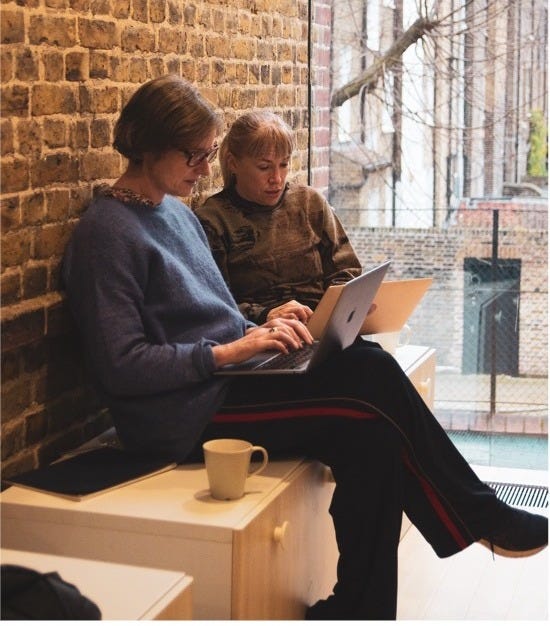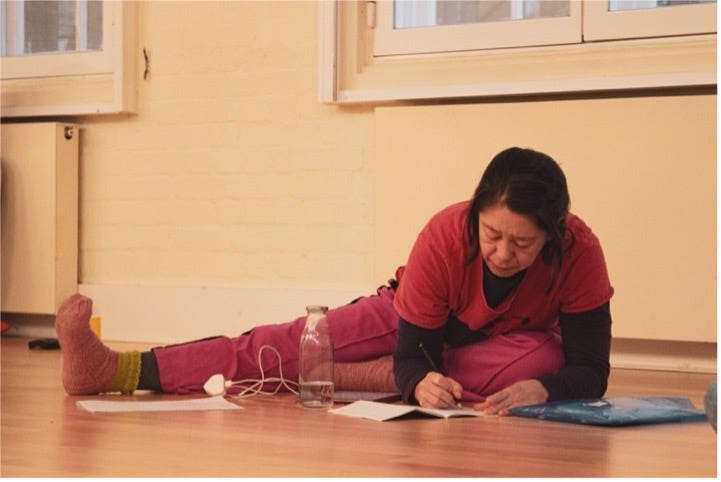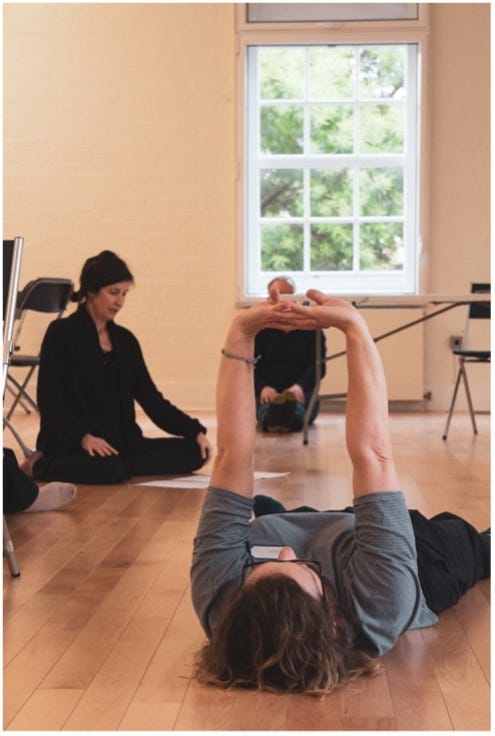Choreography of Consent: Experiments in Dance/Law Research
Introduction
This is the first entry in a blog series about the Choreography of Consent AHRC Network led by Anna Macdonald (Reader in Movement at Central Saint Martins: UAL) and Marie-Andrée Jacob (Professor of Law at the University of Leeds). The Network brings together dance practitioners/researchers and legal scholars to better understand how law ‘moves’ in an embodied way. Using the movement of consent practices as a pilot focus, the Network members explore new ways of working across dance and law through four key events running between September 2025 and March 2026.
In this post, we begin by outlining the Network aims and sharing some initial reflections on our first in-person meeting at Siobhan Davies Studios, London in December 2024.
Anna Macdonald and Marie-Andrée Jacob
We have worked together since 2016 exploring the intersections of dance and law. Our collaboration has focused on how dance can reveal new or understudied the aspects of legal materials. We have looked particularly at the embodied and affective dimensions of processes of retraction, such as deletion, redaction and strikethrough (Jacob and Macdonald 2020). Building on our independent research in this area, (Jacob 2007, Jacob 2017) (Macdonald 2020-2022) the Network focuses on exploring the ways dance-based research can deepen legal understandings of consent, and how legal studies can influence dance practices related to consent.
The Network
The Network consists of a core group of individuals and partner organisations from across dance and law. We wanted to involve and engage with people already doing dance/law work but also reached out to practitioners who are interested in what dance and movement can do as a method beyond dance itself. We sought scholars who think carefully about the impact of their research methods on the thing being researched and who were open to experimenting with embodied and choreographic methods. An important goal of the Network is to extend our knowledge and practice by learning about work done in this sphere which we might otherwise not have come across.
The Network is also supported by a number of organisations, including Independent Dance (ID), People Dancing: the foundation for community dance, and the Institute of
Advanced Legal Studies, who are interested in the potential benefits of dance and law encounters and can help us utilise this work on dance, law and consent in applied and impactful ways. We are also supported by a small Advisory Board with experience in interdisciplinary collaborations, research leadership and public engagement who will help steer our work.
The structure of the first event
The Network is organised around online and in-person gatherings, a symposium, and an exhibition. The work is also shared via blogs, podcasts, and articles.
The aim of Event 1 was to bring core Networks members together to share and scope existing dance/law practice and begin to develop new collaborations. Before the event, Network members were invited to respond to the following question:
‘Coming from your own position, what interests you most about consent? You might offer an example from your own practice; a reflection or reading of your work or from others; an ethnographic artefact including a tangible object or a category; a task or exercise for the group to do, or other form of provocation.’
What people shared.
Some of the work shared focused on somatic approaches to examining/creating what Amy Voris termed ‘the conditions for consent’. This work explored the question ‘How do we feel our “yes,” and how do we feel our “no”(Voris, 2024)? Extending this question into the moment of consent itself, Karen Wood invited us to explore the interplay between softening to and resisting touch.
James Leach brought an anthropological perspective to the relationship of consent and embodied autonomy through a discussion of ‘a vocabulary of ownership.’ James’ sharing resonated with the work of both Jo Fong and Aditi Jaganathan, which brought attention to the challenging relationships between consent, colonialism and compliance. Chantelle Lewis, who we invited to make ethnographic notes for this event, described the way these conversations evoked ‘the white elephant in the room’ (Lewis 2024).
The emphasis of our sharing (Jacob and Macdonald) was on the question of when consent occurs, rather than simply what consent is. The relationship of consent and time was also present in Heni Hale’s exploration of the complexities of sustaining a moving state of consent with the dead in archival contexts. Sara Ramshaw shared reflections from the context of her work in Youth Theatre practice as a site, along with dance studios, where consent has become more contentious in recent years.
Anna Macdonald’s workshop explored the act of making a contract with the floor to hold us up, asking where consent is already assumed, and what can we rely on? The relationship of consent with precarity, physical or otherwise, was also present in Sean Mulcahy’s examination of consent as a movement into the unknown, both in dance and in dark rooms (Mulcahy 2024). Shifting to the area of consent in the civil ceremony of marriage, Jess Connolly-Smith reflected on how highly-formalised, stilted and embodied procedures shape our understanding of how law contributes to enshrine life milestones.
Some early initial thoughts
The Network was developed as part of a desire to respond to the movement of law in ways that involved movement rather than relying solely on words. Whilst we want to use moving research methods to look at something moving (Macdonald 2024) this event made us more aware of the need, at times, to pause the movement and keep some things still, in order to be able to explore other things.
We have begun to recognise that this Network is not about dance and law, after all. Instead, it concerns something about dance and something about law, what these are, and what can happen when they encounter one another. There is a need here to start modestly and further demarcate our ‘terms and conditions’.
Next steps
Over the next 6 months, Network members will be sharing blog posts about the ideas and practices they brought to Event 1 and/or the work they have begun since with other network members. These posts are intentionally speculative responses to the event, designed to open up new lines of thought.
References
Jacob, M., Macdonald, A. (2019) A Change of heart: Retraction and the body. Law Text Culture, 23, 262–275.
Jacob, M.-A., (2017) The strikethrough: an approach to regulatory writing and professional discipline. Legal Studies, 37:1, 137-161.
Jacob, M.-A. (2007) Form-Made Persons: Consent Forms as Consent’s Blind Spot.
PoLAR: Political and Legal Anthropology Review 30:2, 249-268.
Macdonald, A (2024) Keeping in time: Mastery, as a condition of colonial and patriarchal discourse, and the temporality of screendance. In LO:TECH:POP:CULT : Screendance Remixe. London: Routledge.
Macdonald, A. Ways of doing things (2020-2022)





